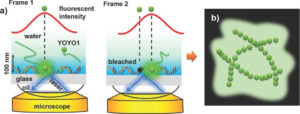
Diagram of point accumulation for imaging in nanoscale topography used for YOYO-1 dye molecule (Illustration: Beilstein Journal of Nanotechnology)
By Raymond Humienny
NQPI editorial intern
Nanoscale and Quantum Phenomena Institute member and Chemistry & Biochemistry professor Jixin Chen has developed a new method to optimize the fluorescence imaging of DNA structures. Although fluorescent imaging techniques are nothing new, Chen’s formulation will enhance the resolution of fine images at the nanoscale.
Among the techniques used to illuminate particles on the nanoscale, fluorescence is the emission of light from atoms or molecules excited by a photon. For Chen, the molecule of interest is a dye called YOYO-1, a particle capable of resolving fine DNA images below 250 nanometers.
Since this level of measurement is lower than the diffraction limit of visible light, the resolution of an entire image in Chen’s study must be constructed one dye at a time.
YOYO-1 is not fluorescent before binding to the DNA structure, and after binding, it remains fluorescent until photo-bleached – or “turned off.”
“We need to find a balance,” Chen said. “Where is the balance between the bleaching and the absorption?”
In an article published in the Beilstein Journal of Nanotechnology, Chen produced individual frames of excited YOYO-1 molecules using a method called point accumulation for imaging in nanoscale topography (PAINT). This process involves adding together the individual frames of excited YOYO-1 molecules along the range of the DNA measured. As a result, the summation of points creates a resolved image of the DNA structure.
Following this procedure, he would determine the binding rate of each particle and its position along the DNA. As a result, Chen proposed a formula to optimize PAINT imaging.
For this study, Chen excited individual YOYO-1 dyes in DNA solution using a 473 nm laser. With each new dye added, Chen needed to photo-bleach the previously excited YOYO-1 molecule. After doing this, he would determine the binding rate of each particle and determine its position along the DNA. As a result, Chen proposed a formula to optimize PAINT imaging.
“If a second dye (is) bound to the DNA with the first one present, we cannot resolve (the image),” Chen said. “There is a huge background noise next to the first dye, so you have to bleach it fast enough at the same time the new molecule is coming.”
Although Chen said the research was fundamental for fluorescence techniques, it provides a starting point for later research on topics such as DNA origami, virus imaging and gene regulation.
“The final conclusion of this is that we can measure the bleaching rate separately, and we can calculate the diffusion rate,” Chen said. “Then we can find statistical balance between the power density (of the laser) and the amount of solution we need for imaging.”


















Comments